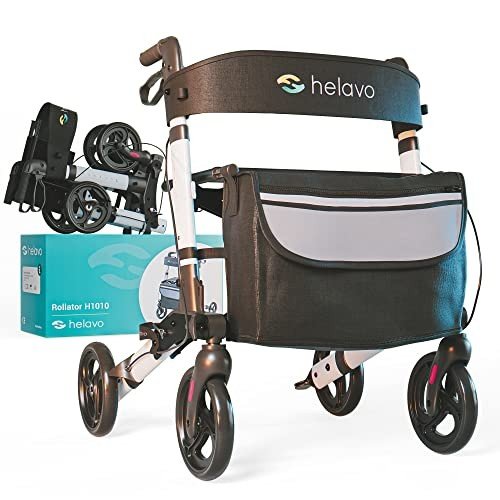This company has no active jobs
0 Review
Rate This Company ( No reviews yet )
Company Information
- Total Jobs 0 Jobs
- Category SESSI
- Location United States
About Us
Rollator Walker Explained In Fewer Than 140 Characters
The Comprehensive Guide to Rollator Walkers
As the population ages, the demand for mobility aids like rollator walkers has actually risen. These walkers supply stability, assistance, and liberty of motion for people handling mobility issues, be they momentary or persistent. Comprehending the types of rollator walkers readily available, their benefits, features, and how to choose the right one can considerably enhance the lifestyle for both the user and their caretakers.
What is a Rollator Walker?
A rollator walker is a mobility aid designed to assist people maintain their self-reliance while walking. It includes a frame with 4 wheels, hand brakes, and a seat, making it suitable for users requiring additional support without the complete restrictions of traditional walkers.
Key Features of Rollator Walkers
Rollator walkers come equipped with various functions designed to improve user experience. Here are a few of the most common functions:
- Four-Wheel Design: The most appreciable function is its 4 wheels, which permit smoother transitions over various surfaces.
- Cushioned Seat: Many rollators come with a built-in seat, providing a resting point for users who may tire quickly.
- Hand Brakes: Most designs have hand brakes that enable users to protect the walker in location when sitting or browsing unequal surface areas.
- Storage Options: Many rollators include a basket or storage pouch for personal items, such as water bottles or little bags.
- Adjustable Height: Users can tailor the height of the deals with for ideal comfort and posture.
Benefits of Using a Rollator Walker
Rollator walkers use numerous advantages. They can considerably enhance mobility and safety for users. Here are some crucial benefits:
- Enhanced Stability: With four wheels and a sturdy frame, rollators offer superior stability compared to standard walkers.
- Practical Seating: The integrated seat allows users to rest whenever needed, promoting longer outings without tiredness.
- Increased Confidence: The included assistance can assist users feel more secure throughout walks, which can result in longer ranges traveled.
- Enhanced Posture: With adjustable heights, users can keep a more natural posture while walking, which can minimize pain.
- Self-reliance: Rollators make it possible for lots of people to gain back or preserve self-reliance in their day-to-day activities.
Kinds Of Rollator Walkers
Rollator walkers come in various styles and variations to fulfill individual needs. Here are a few common types:
| Type | Description |
|---|---|
| Standard Rollator | Basic four-wheeled design created for indoor and outdoor use. |
| Junior Rollator | A smaller variation tailored for much shorter people or kids. |
| Durable Rollator | Constructed to accommodate bigger body weights and provide extra stability. |
| Three-Wheel Rollator | Compact style suitable for navigating tight spaces. |
| Rollator with Seat | Features an integrated seat for resting during use. |
| Rollator with Storage | Comes with removable baskets or pouches for easy transport of personal products. |
Selecting the Right Rollator Walker
Choosing the right rollator walker involves thinking about user requirements, choices, and physical requirements. Here are some aspects to consider:

- User Height and Weight: Ensure the walker can support the person’s weight and can be adapted to their height.
- Terrain: Consider where the walker will mainly be used. Removable wheels can help move smoothly over rough terrains.
- Storage Needs: Determine if extra storage area is essential for the user’s daily needs.
- Mobility: If regular transport is required, lightweight models or those that fold for easy storage needs to be chosen.
- Budget plan: Prices can vary considerably; guarantee the picked walker offers value without sacrificing quality.
Maintenance of Rollator Walkers
Appropriate maintenance can improve the lifespan of a rollator walker. Here are some pointers for keeping it in excellent condition:
- Regular Check-ups: Periodically check brakes and wheels for wear and tear.
- Tidy the Walker: Use a mild cleaning agent and cloth to wipe down surface areas and get rid of dirt.
- Look For Loose Parts: Tighten any screws or bolts that might end up being loose with regular use.
- Change Parts as Needed: Wheels, hand grips, and brakes can use out and may need replacement for maximum performance.
FAQs About Rollator Walkers
Q1: What is the average weight limit for a rollator walker?A: Most basic rollator walkers support weights between 250 to 300 pounds, while sturdy designs can accommodate as much as 500 pounds. Q2: Can rollator walkers be utilized outdoors?A: Yes, lots of rollatorsare developed for outdoor use. Those with
bigger wheels and robust frames are especially fit for unequal surface areas. Q3: Do rollator walkers feature warranties?A: Many manufacturers offer guarantees ranging from 1
to 5 years on the frame and parts, guaranteeing sturdiness and user fulfillment. Q4: How do I properly adjust a rollator walker?A: Adjust the manages to a height that enables the user to stand upright with
elbows a little bent when holding the handles. Q5: Can
I use a rollator walker for rehabilitation?A: Yes, rollators are often used in rehab settings to enhance walking self-confidence and mobility
after injuries or surgeries. Rollator walkers
are important tools that provide boosted mobility and independence for numerous people. By understanding the types, benefits, and proper usage of rollator
walkers, users can make educated decisions that best fit their way of life and requirements. Whether recuperating from an injury or handling a long-lasting condition, a rollator walker can make a substantial distinction in the quality of life, allowing individuals to restore their freedom and confidence while moving about the world.
